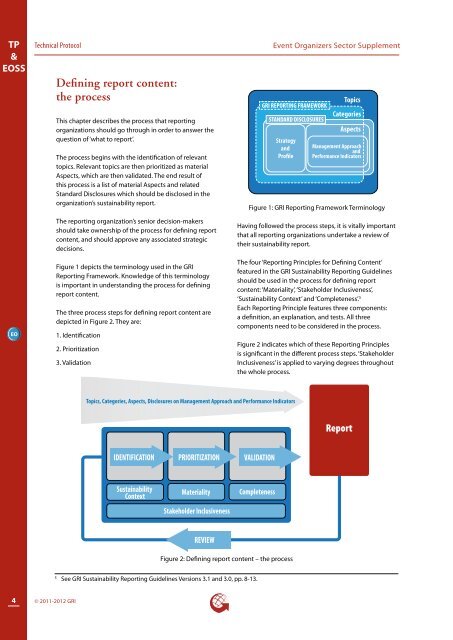Event Organizers Sector Supplement - Global Reporting Initiative
Event Organizers Sector Supplement - Global Reporting Initiative
Event Organizers Sector Supplement - Global Reporting Initiative
Create successful ePaper yourself
Turn your PDF publications into a flip-book with our unique Google optimized e-Paper software.
TP<br />
&<br />
EOSS<br />
EO<br />
Technical Protocol<br />
Defining report content:<br />
the process<br />
This chapter describes the process that reporting<br />
organizations should go through in order to answer the<br />
question of ‘what to report’.<br />
The process begins with the identification of relevant<br />
topics. Relevant topics are then prioritized as material<br />
Aspects, which are then validated. The end result of<br />
this process is a list of material Aspects and related<br />
Standard Disclosures which should be disclosed in the<br />
organization’s sustainability report.<br />
The reporting organization’s senior decision-makers<br />
should take ownership of the process for defining report<br />
content, and should approve any associated strategic<br />
decisions.<br />
Figure 1 depicts the terminology used in the GRI<br />
<strong>Reporting</strong> Framework. Knowledge of this terminology<br />
is important in understanding the process for defining<br />
report content.<br />
The three process steps for defining report content are<br />
depicted in Figure 2. They are:<br />
1. Identification<br />
2. Prioritization<br />
3. Validation<br />
<strong>Event</strong> <strong>Organizers</strong> <strong>Sector</strong> <strong>Supplement</strong><br />
GRI REPORTING FRAMEWORK<br />
STANDARD DISCLOSURES<br />
Strategy<br />
and<br />
Profile<br />
Topics<br />
Categories<br />
Aspects<br />
Management Approach<br />
and<br />
Performance Indicators<br />
Figure 1: GRI <strong>Reporting</strong> Framework Terminology<br />
Having followed the process steps, it is vitally important<br />
that all reporting organizations undertake a review of<br />
their sustainability report.<br />
The four ‘<strong>Reporting</strong> Principles for Defining Content’<br />
featured in the GRI Sustainability <strong>Reporting</strong> Guidelines<br />
should be used in the process for defining report<br />
content: ‘Materiality’, ‘Stakeholder Inclusiveness’,<br />
‘Sustainability Context’ and ‘Completeness’. 5<br />
Each <strong>Reporting</strong> Principle features three components:<br />
a definition, an explanation, and tests. All three<br />
components need to be considered in the process.<br />
Figure 2 indicates which of these <strong>Reporting</strong> Principles<br />
is significant in the different process steps. ‘Stakeholder<br />
Inclusiveness’ is applied to varying degrees throughout<br />
the whole process.<br />
Topics, Categories, Aspects, Disclosures on Management Approach and Performance Indicators<br />
Report<br />
IDENTIFICATION<br />
PRIORITIZATION<br />
VALIDATION<br />
Sustainability<br />
Context<br />
Materiality<br />
Stakeholder Inclusiveness<br />
Completeness<br />
REVIEW<br />
Figure 2: Defining report content – the process<br />
5<br />
See GRI Sustainability <strong>Reporting</strong> Guidelines Versions 3.1 and 3.0, pp. 8-13.<br />
4<br />
© 2011-2012 GRI

















